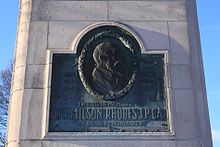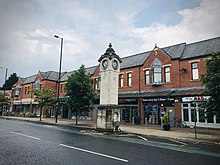John Milson Rhodes
Dr John Milson Rhodes (1847- 25 September 1909) was a general practitioner in the suburb of Didsbury, Manchester, UK. He was noted as a pioneer of social reform.

He was born at Broughton, Salford in 1847 and studied medicine in Glasgow and at Owen's College, Manchester. He was a member of the Chorlton Board of Guardians from 1882 and involved with the workhouse which later became Withington Hospital.[1] He helped to set up the Styal Cottage Homes. He established the Northern Workhouse Nursing Association and the Chorlton workhouse became a pioneer of trained nursing, held out by Florence Nightingale as an example.
He established the Langho Colony for Epileptics in 1904 and was involved with the David Lewis Epileptics Colony.[2]
Death and memorials

He died from the effects of strychnine which he administered to himself.[3]
After his death, a 8-metre (26 ft) clock tower was erected in his memory in the forecourt of Didsbury railway station. The Edwardian Baroque Portland stone clock incorporates a pair of drinking fountains and bears a bronze plaque which displays a relief medallion portrait of Rhodes. The inscription reads "In memory of Dr.J.Milson Rhodes JP.CA. 1847-1909. A Friend to Humanity". Although the station was demolished in 1982, the clock still stands as a local landmark and is Grade II listed.[4]
In 2017 a Wetherspoons public house in Didsbury, the Milson Rhodes, was named after him.[5]
| Wikimedia Commons has media related to John Milson Rhodes. |
References
- France, E.; Woodall, T. F. (1976) A New History of Didsbury. Manchester. E. J. Morten; pp. 81–83
- "Celebrating a visionary doctor". Manchester Evening News. 7 May 2010. Retrieved 21 March 2017.
- "JOHN MILSON RHODES, M.D., J.P". British Medical Journal. 2: 1104. 9 October 1909. Retrieved 21 March 2017.
- Historic England. "Rhodes Memorial Clock (1270515)". National Heritage List for England. Retrieved 7 July 2020.
- "The Botanist To Replace Wetherspoons In Didsbury". Manchester Confidentials. 18 November 2016. Retrieved 21 March 2017.